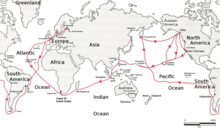
Vitus Jonassen Bering, also known as Ivan Ivanovich Bering, was a Danish cartographer and explorer in Russian service, and an officer in the Russian Navy. He is known as a leader of two Russian expeditions, namely the First Kamchatka Expedition and the Great Northern Expedition, exploring the north-eastern coast of the Asian continent and from there the western coast on the North American continent. The Bering Strait, the Bering Sea, Bering Island, the Bering Glacier, and Vitus Lake were all named in his honor.

Adelbert von Chamisso was a German poet, writer and botanist. He was commonly known in French as Adelbert de Chamissode Boncourt, a name referring to the family estate at Boncourt.
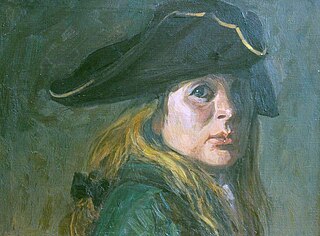
Georg Wilhelm Steller was a German-born naturalist and explorer who contributed to the fields of biology, zoology, and ethnography. He participated in the Great Northern Expedition (1733–1743) and his observations of the natural world helped the exploration and documentation of the flora and fauna of the North Pacific region.
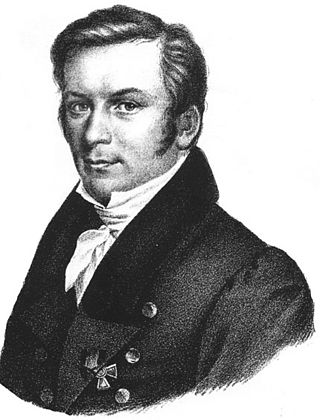
Johann Friedrich Gustav von Eschscholtz was a Baltic German physician, naturalist, and entomologist. He was one of the earliest scientific explorers of the Pacific region, making significant collections of flora and fauna in Alaska, California, and Hawaii.

Faddey Faddeyevich Bellingshausen was a cartographer, explorer, and naval officer of the Russian Empire, who attained the rank of admiral. He participated in the first Russian circumnavigation of the globe, and subsequently became a leader of another circumnavigation expedition that discovered the continent of Antarctica. Like Otto von Kotzebue and Adam Johann von Krusenstern, Bellingshausen belonged to the cohort of prominent Baltic German navigators who helped Russia launch its naval expeditions.

Friedrich Benjamin Graf von Lütke, more commonly known by his Russian name Fyodor Litke, was a Russian navigator, geographer, and Arctic explorer. He became a count in 1866, and an admiral in 1855. He was a corresponding member (1829), Honorable Member (1855), and President (1864) of the Russian Academy of Science in St. Petersburg. He was also an Honorable Member of many other Russian and foreign scientific establishments, and a corresponding member of the French Academy of Science in Paris.
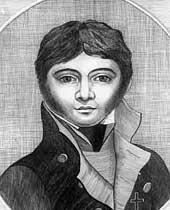
Dmitry Leontiyevich Ovtsyn was a Russian hydrographer and Arctic explorer. The Ovtsyn family is one of the oldest Russian noble families, originating from the descendants of Rurik, the Murom princes.

Georg Heinrich Freiherr von Langsdorff was a German naturalist and explorer, as well as a Russian diplomat, better known by his Russian name, Grigori Ivanovich Langsdorf.

Louis Choris (1795–1828) was a German-Russian painter and explorer.

The Great Northern Expedition or Second Kamchatka Expedition was one of the largest exploration enterprises in history, mapping most of the Arctic coast of Siberia and some parts of the North American coastline, greatly reducing "white areas" on maps. It was conceived by Russian Emperor Peter the Great, but implemented by Russian Empresses Anna and Elizabeth. The main organiser and leader of the expedition was Vitus Bering, who earlier had been commissioned by Peter I to lead the First Kamchatka Expedition. The Second Kamchatka Expedition lasted roughly from 1733 to 1743 and later was called the Great Northern Expedition due to the immense scale of its achievements.

Nadezhda was a three-masted sloop, the ex-British merchantman and slave ship Leander, launched in 1799. A French privateer captured her in 1801, but she quickly came back into British hands. Private Russian parties purchased her in 1802 for the first Russian circumnavigation of the world (1803-1806), and renamed her. Although it is common to see references to the "frigate Nadezhda", she was a sloop, not a frigate, and she was never a warship. After her voyage of exploration she served as a merchant vessel for her owner, the Russian-American Company, and was lost in 1808.
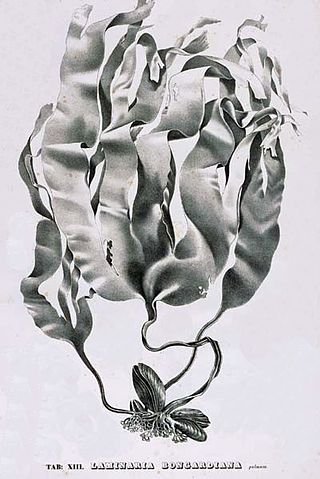
Alexander Filippovich Postels, was a Russian naturalist, mineralogist and artist of Baltic German descent.

Johann Caspar Horner was a Swiss physicist, mathematician and astronomer.

The first Russian circumnavigation of the Earth took place from August 1803 to August 1806 and was carried out on two ships, the Nadezhda and the Neva, under the commands of Adam Johann von Krusenstern and Yuri Lisyansky, respectively. The expedition had complementary economic, diplomatic, and exploratory goals.

The era of European and American voyages of scientific exploration followed the Age of Discovery and were inspired by a new confidence in science and reason that arose in the Age of Enlightenment. Maritime expeditions in the Age of Discovery were a means of expanding colonial empires, establishing new trade routes and extending diplomatic and trade relations to new territories, but with the Enlightenment scientific curiosity became a new motive for exploration to add to the commercial and political ambitions of the past. See also List of Arctic expeditions and List of Antarctic expeditions.
Early Polynesian explorers reached nearly all Pacific islands by 1200 CE, followed by Asian navigation in Southeast Asia and the West Pacific. During the Middle Ages, Muslim traders linked the Middle East and East Africa to the Asian Pacific coasts, reaching southern China and much of the Malay Archipelago. Direct European contact with the Pacific began in 1512, with the Portuguese encountering its western edges, soon followed by the Spanish arriving from the American coast.

Adam Johann von Krusenstern was a Baltic German admiral of the Russian Empire and the explorer who led the first Russian circumnavigation of the Earth in 1803–1806.
The history of exploration by citizens or subjects of the Russian Federation, the Soviet Union, the Russian Empire, the Tsardom of Russia and other Russian predecessor states forms a significant part of the history of Russia as well as the history of the world. At 17,075,400 square kilometres (6,592,850 sq mi), Russia is the largest country in the world, covering more than a ninth of Earth's landmass. In the times of the Soviet Union and the Russian Empire, the country's share in the world's landmass reached 1/6. Most of these territories were first discovered by Russian explorers. Contiguous exploration in Eurasia and the building of overseas colonies in Russian America were some of the primary factors in Russian territorial expansion.

Ernst Reinhold von Hofmann was a Russian geologist, geographer, explorer, and lecturer. He was a geologist who accompanied Otto von Kotzebue and his crew during his travels around the world from 1823 to 1826. After that, he made several travels to regions such as the Urals and Continental Europe and made note of orography and general geography. He was also a professor at Saint Petersburg State University and an associate professor at the University of Kyiv.
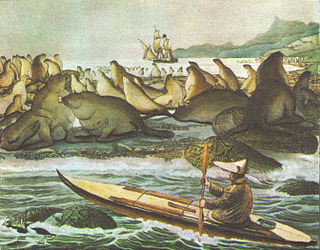
The Russian Rurik Expedition was a circumnavigation of the world that took place from July 30, 1815 to August 3, 1818 under the command of Otto von Kotzebue and was intended to discover and explore the Northwest Passage. The expedition of the warship Rurik was equipped and financed by the Russian Count Nikolai Petrovich Rumyantsev. It took place with the benevolent support of Tsar Alexander I. Due to adverse weather conditions, however, it did not reach its destination and returned earlier than planned. The historical significance of the expedition lies in the number of new discoveries along the entire route as well as the human and cultural experiences that the crew brought back from this three-year journey.

